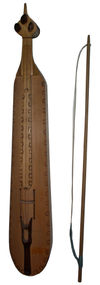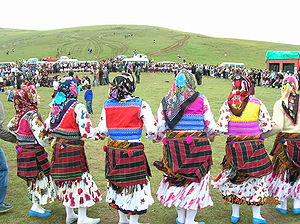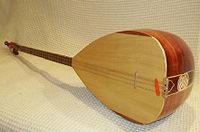- Chepni people
-
Chepni(s) 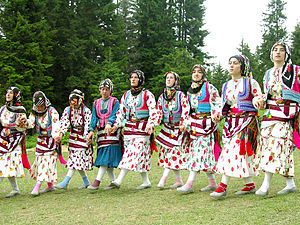
Chepni youth[1] from Ağasar Valley, Şalpazarı, Trabzon Province dancing to Kemençe music. To maintain these type of traditional dresses in Ağasar, every year, traditional festivals are held by the people of Şalpazarı. Total population (see also Turkish population & Turkish diaspora) Regions with significant populations  Turkey
Turkeymore than 3 500 000 up to 5 000 000[citation needed] (by 2009) in Sinop, Samsun, Tokat, Ordu, Giresun, Tirebolu, Görele, Şalpazarı, Trabzon, Şanlıurfa, Konya, Gümüşhane and Rize also in Istanbul and Balıkesir .[2][3]  Georgia
Georgiaunknown in Batumi[note 1]  Bulgaria
Bulgariaunknown, Chepnedje tribe.  Greece
Greeceunknown, Pontic Greek refugees with mixed heritage.  Syria
Syriaunknown, amongst Turkmens in Aleppo.[2][3]  United States
United Statesapprox. 15 000 in New Jersey (from Yağlıdere) [4][5][6][7] See also; Turkish Americans  Azerbaijan
AzerbaijanUnknown in Şamaxı, Göyçay and Quba , and Kalbajar before Armenian occupation of Karabakh Languages Religion Related ethnic groups The Chepni (Turkish: Çepni (pronounced [tʃepni], Ottoman Turkish: چپنى [8], Çepniler, Çepni boyu, Çepni oymağı, Romeika: Τζαπνήδες , Tzapnēdes,[2] Old Uyghur Turkic in Arabic script: جآپنِ[9]) or Chepni Turkmens[10][page needed] are a Turkish boy or oymak (clan).[2][11]
They live in the Eastern Black Sea region (primarily in Trabzon Province, Giresun Province and Ordu Province[note 2]) of Turkey and some other communities of Chepni live in Balıkesir Province.[2]
In the legend of Oghuz Qaghan, the Chepni was one of the clans of the tribe of Gök Han that consists of Pecheneg (Beçenek ), Bayandur (Bayındır ), Chavuldur (Çavuldur ) and Chepni, a part of Üç-Oklar branch of Oghuz Turks.[12] According to Mahmud al-Kashgari's Diwan Lugat at-Turk (Arabic: ديوان لغات الترك, "Compendium of Turkic Dialects"), it was 21st tribe of the 22 tribes.[9]
Their religion is Islam (Sunni and Alevi). According to a Turkish historian Faruk Sümer, first murids of Hajji Bektash were Chepni residents of Suluca Kara Üyük (now a town of Nevşehir Province in the Central Anatolia region of Turkey)[13] and some Turkish historians claim that Hajj Bektash was Chepni origin.[14]
Contents
History
Chepnis are originally a part of Oghuz confederacy during Göktürk period. With other Turkoman tribes, they migrated to Anatolia from Khorasan during 13th century. In 1277, they settled the city of Giresun and they built ships there. They fought against the Empire of Trebizond. Following the conquest of Trabzon by Mehmed II, they settled Trabzon, Rize and Batumi.[2] During both 16th and 17th centuries, Chepnis were among Ottoman sipahis who fought against Holy Roman Empire (Habsburgs). During the reign of Murad IV, the Ottoman government wanted some of Chepni to leave Safavid borders, and some Chepnis migrated to Aleppo.
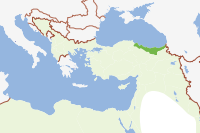 Trabzon Vilayet within Ottoman borders of 1878. This region also shows where Chepnis mainly settled in the Ottoman Empire.
Trabzon Vilayet within Ottoman borders of 1878. This region also shows where Chepnis mainly settled in the Ottoman Empire.
Some scholars think that some tribes in Turkmenistan and some Turkish communities in Dobrudja region of Bulgaria may have assimilated Chepni elements.[2][3]
Culture
Chepnis are believed to be one of the most important tribes of the Oghuz confederacy because of their colonies in eastern Black Sea region.[2][3]
Music
The traditional Chepni Turkish instrument is Kemençe. Picoğlu Osman, who is a Chepni, is among the best virtuosi of Kemençe.
Chepni folk dance is called Horon, which is also the common dance style of the Eastern Black Sea region of Turkey.
Mount Sis Festival is also an important festival that takes place in the cultural life of Chepnis.
Dialects
Vilayet-i Çepni Dialect
with the name of Vilayet-i Çepni was a vilayet in the Eastern Black Sea Region during the reign of Selim I of the Ottoman Empire.
Chepnis speak a variant of Turkish language. The usage of velar nasal is common amongst them unlike Istanbul dialect. Some Old Turkic words including "bıldır" ("last year" in old Turkic) are still known.[15] This dialect also has a few borrowed words from Romeika language. Görele, Çanakçı and Şalpazarı are the towns where this dialect has many speakers.
Some examples
- "senin" /ˈsenin/ (your) is pronounced /ˈseːŋ/ or /seˈniŋ/, sometimes /seˈniɲ/
- "bugün" /buˈɡyn/ (today) is pronounced /bøːn/ or /bøˠn/
Black Sea Dialect
Other Chepni communities in the city centres of Trabzon and Rize speak Black Sea accent also known as Laz dialect of the Turkish language (not to be confused with the Laz language).
Notable people
- Picoğlu Osman, Kemençe player
- Hasan Âli Yücel[citation needed]
- Bedri Rahmi Eyüboğlu, painter and poet
See also
Links
Notes
References
- ^ Horon in www.geyiklibeldesi.com
- ^ a b c d e f g h Sümer, Faruk, Çepniler[page needed]
- ^ a b c d Çelik, Ali, Çepnilerin Anadolu'nun Türkleştirilmesindeki Yeri Ve Önemi[page needed]
- ^ Yağlıdereliler Amerika'yı Mesken Tuttu :: Giresun, Giresun ilçelerinin en güncel haber sitesi
- ^ HABER: Giresun: Amerika'daki "Yağlıdere" haberi
- ^ ::Yağlıdere İlçesi Web Sitesi::
- ^ ABD Vizeleri ile İlgili Açıklama (12 Şubat 2010) – AMERİKAN BÜYÜKELÇİLİĞİ( ANKARA, TÜRKİYE)
- ^ Redhouse, Sir James, Turkish–English Dictionary[page needed]
- ^ a b c Besim Atalay (ed.), Divanü Lügati't - Türk, Cilt I, Türk Tarih Kurumu Basımevi, 2006, ISBN 975-16-0405-2, p. 57.
- ^ Haldon, John, The Palgrave Atlas of Byzantine History, ISBN 9780230243644 Chepni Türkmen
- ^ Magnarella, Paul, Tradition and change in a Turkish town, Schenkman Pub. Co., 1981, p 35.
- ^ Faruk Sümer, Oğuzlar: Türkmenler, Tarihleri, Boy Teşkilâtı, Destanları, Türk Dünyası Araştırmaları Vakfı, 1992, ISBN 9789754980486, p. 172.
- ^ Faruk Sümer, Çepniler: Anadolu'daki Türk Yerleşmesinde Önemli Rol Oynayan Bir Oğuz Boyu, Türk Dünyası Araştırmaları Vakfı, 1992, ISBN 9754980527, p. 22.
- ^ Halil İbrahim Türkyılmaz, Dünden Yarına Tüm Yönleriyle Eynesil, Eynesilliler Kültür ve Yardımlaşma Derneği, 1995, p. 50.
- ^ Kuşçulu Köyü Kitabı, Köyün yerel kelimeleri section[clarification needed]
Categories:- Chepnis
- Oghuz Turks
Wikimedia Foundation. 2010.


